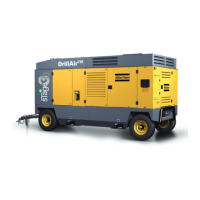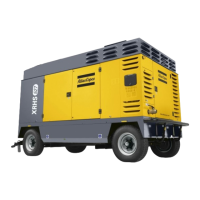Do you have a question about the Atlas Copco XRVS 647 and is the answer not in the manual?
| Model | XRVS 647 |
|---|---|
| Type | Rotary Screw Compressor |
| Free Air Delivery | 47.2 l/s (100 cfm) |
| Working Pressure | 7-13 bar (100-190 psi) |
| Weight | 950 kg |
| Motor Power | 37 kW |
| Length | 2500 mm |
| Width | 1450 mm |
| Drive Type | Diesel |
Universal safety rules applicable to all operations and maintenance.
Guidelines for safe movement and setup of the compressor unit.
Precautions for operating the compressor safely and efficiently.
Procedures to ensure safety during service and repair tasks.
Detailed safety rules for batteries, pressure vessels, and safety valves.
Details on pneumatic and electronic regulating systems for pressure and flow control.
Instructions for manual and automatic operation of parking and service brakes.
Procedure for releasing the spring-loaded parking brake in emergency situations.
Essential safety guidelines for moving and lifting the compressor.
Broad safety advice for operating the compressor, including towing and coupling.
Specific safety measures for towing high-speed EU tandem undercarriages.
Guidelines for safely lifting the compressor using appropriate equipment.
Steps to perform before initial unit startup, including fluid checks and fuel selection.
Safety precautions and steps for starting/stopping and battery switch usage.
Explanation of the POWER OFF/ON, START, and STOP buttons on the control panel.
Guide to icons and main view indicators on the control panel display.
Detailed explanation of various icons representing status, operation modes, and alarms.
Description of Main, Measuring, Setup, and Alarm views and navigation.
Steps for controller initialization and checking vessel pressure before starting.
Process of issuing start commands and engine preheating sequence.
Explanation of automatic and manual DPF regeneration, including soot load indicators.
How to inhibit DPF regeneration and consequences of increased soot load.
Procedure to manually initiate DPF regeneration when needed.
Comprehensive list of fault codes, alarm texts, failure classes, and triggers.
Correct use and operation of the emergency stop button.
Liability, service paks, kits, storage, and general safety precautions for maintenance.
Schedule detailing maintenance tasks and intervals for the compressor.
Troubleshooting steps for low compressor capacity or pressure issues.
Solutions for high receiver pressure, shutdown switches, and oil/air mist from filters.
Steps to resolve compressor overheating and common alternator precautions.
Performance data including free air delivery and fuel consumption at various settings.
Detailed fuel consumption rates and sound pressure/power levels.











